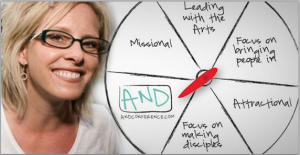Last week I wrote about the Wired Churches Communications Coaching Network I joined, led by Kem Meyer, author of Less Clutter, Less Noise: Beyond Bulletins, Brochures And Bake Sales and Director of Communications at Granger Community Church.
Being the great communicator she is, I thought I’d interview Kem about church communications and this network. If you have any role in communications ministry at your church, this is for you. If you don’t, send this link to your pastor or communications director — they will likely be glad you did.
Bobby Gilles: Many people have either read Less Clutter, Less Noise, or seen you speak at a conference, or maybe they follow your blog. What is the top thing(s) they will get out of joining this coaching network that they can’t get from those other things?
Kem Meyer: There are two unique attributes in the coaching environment you can’t find at a workshop, conference or blog post. First, is the alliance and journey with a small, closed group of peers who have roles, challenges and opportunities similar to your own.
The second is a challenging, interactive and highly personalized learning experience that is hard to describe until you’ve benefited from it. While a coaching network isn’t for everyone, it’s the perfect fit for anyone who is looking for focused, up close and personal attention in a safe forum where they can be blunt about the challenges they face and get frank, encouraging insight in return.
 I saw a recent TED talk where analyst Richard St. John shared 8 secrets of success. Looking at those 8 ingredients and the four seasons of coaching networks I’ve facilitated so far, here’s how I would break it down.
I saw a recent TED talk where analyst Richard St. John shared 8 secrets of success. Looking at those 8 ingredients and the four seasons of coaching networks I’ve facilitated so far, here’s how I would break it down.
BEFORE: coaching participants show up with these ingredients: 1) passion, 2) serve and 3) good
DURING: the network helps supplement these ingredients: 4) push, 5) ideas and 6) focus
AFTER: coaching participants leave with the ability to follow through on the final ingredients: 7) work and 8 ) persist
Bobby Gilles: When you are sifting through applicants and putting coaching networks together, what are some of the things you look for (in terms of who you accept and who you put together in a network)? Do these kinds of things make a difference, and how so:
- Size of church
- Location
- Denomination
- Things the applicant wants to learn
Kem Meyer: While I look at those things for context, they’re not the deciding factors. The principles and challenges that come with the not-so-simple art of communication apply to any environment—regardless of the style or size. So, I look for the people who are trying to lead change and looking for help improving their mindset, not just their skill set.
I also look for the applications that communicate a heart for influencing change—from the ground up—not the top down (even if they are in a senior role). I particularly look for applicants asking questions that require more than a Google search to find the answer to (you’d be surprised).
Finally, I look for the select few who demonstrate commitment to investing the time, energy and money for the journey. Again, it’s not for everyone.
Bobby Gilles: With so many constant, rapid changes in communications tools and channels (particularly online), what do you say to someone who may fear that the info they’d get will soon become too dated to be of use?
Kem Meyer: Easy. If you’re focusing on finding answers to the “why” questions instead of the “what” and “how”, you’ll never be out of date.
Bobby Gilles: You’ve said that effective communications is about “releasing the right response” not “sending the right message.” What does this mean, and how will people who join your network be better prepared and inclined to release right responses?
Kem Meyer: The “right message” assumes you and the other person will respond in the same way. Until we learn about our audiences, large or small, we’ll never know how we’re coming across or how people might respond. It’s delusional to think everyone sees and hears things exactly as we do.
This network is all about curing the disease of familiarity and fine-tuning our M.O.–corporately and individually–to remove barriers to the message.


{ 3 trackbacks }